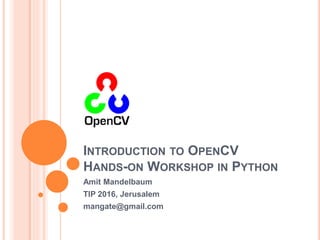
Introduction to OpenCV
- 1. INTRODUCTION TO OPENCV HANDS-ON WORKSHOP IN PYTHON Amit Mandelbaum TIP 2016, Jerusalem mangate@gmail.com
- 2. OVERVIEW OpenCV is the most popular Image Processing and Computer Vision library Free for both academic and commercial use Very easy to learn It has C++, C, Python and Java interfaces and supports Windows, Linux, Mac OS, iOS and Android Designed for computational efficiency and with a strong focus on real-time applications Lot of documentation online
- 3. RESOURCES Official site: http://opencv.org/ Tutorials http://docs.opencv.org/3.0- beta/doc/py_tutorials/py_tutorials.html (official, python) http://docs.opencv.org/2.4/doc/tutorials/tutorials.html (official c++) https://opencv-python-tutroals.readthedocs.io/en/latest/ (python) http://opencvexamples.blogspot.com/ (c++) http://www.pyimagesearch.com/ (some cool free advanced tutorials) Google
- 4. WORKSHOP OUTLINE (TOPICS) Loading, showing and saving images Histograms and Histograms equalizations Gamma correction Smoothing, sharpening and noise removal Morphological operations (erosion, dilation) Edge detection Transformation Adaptive thresholding And finally: Document scanner
- 5. LOADING, SHOWING AND SAVING IMAGES Loading: image = cv2.imread(“file_name",0) (0 means Gray Scale, no number will use original image’s colors) Displaying: cv2.imshow(“some headline",image) (Usually followed by: cv2.waitKey(0) so the image will not close immediately) Saving: cv2.imwrite(“file_name",image) Code: load_and_display.py
- 6. HISTOGRAMS AND HISTOGRAMS EQUALIZATIONS Histogram: Showing how many pixels have a certain intensity (between 0 and 255) in a picture.
- 7. HISTOGRAMS AND HISTOGRAMS EQUALIZATIONS (CONT.) “Good” pictures have their histograms nearly equally spread over the entire range. However in a lot of pictures this is not always the case
- 8. HISTOGRAMS AND HISTOGRAMS EQUALIZATIONS (CONT.) Solution: Histogram equalization (see theoretical equations here: http://www.math.uci.edu/icamp/courses/math77c/demos/hist_eq.pdf) With openCV: image2 = cv2.equalizeHist(image) Code: load_and_display.py
- 9. HISTOGRAMS AND HISTOGRAMS EQUALIZATIONS (CONT.) On color images: Split the color channels with: b,g,r = cv2.split(image) Equalize each channel separately Merge the channels with: image2 = cv2.merge((b,g,r)) Code: equalizing_color_images.py
- 10. GAMMA CORRECTION Sometimes images are too dark, or too bright Fixing it with just adding/substracting intensities produses bad results Solution: Gamma correction Transform intensities from [0,255] to [0,1] with a LUT (look up table) Apply this to all pixels: O = I ^ (1 / G) (G is the gamma value, higher = brighter) Transform back to [0,255] with LUT
- 11. GAMMA CORRECTION (CONT.) In openCV: def adjust_gamma(image, gamma=1.0): invGamma = 1.0 / gamma table = np.array([((i / 255.0) ** invGamma) * 255 for i in np.arange(0, 256)]).astype("uint8") return cv2.LUT(image, table) adjusted = adjust_gamma(original, gamma=2) Code: gamma_correction.py
- 12. SMOOTHING, SHARPENING AND NOISE REMOVAL Smoothing is done by applying a simple filter to the picture, for example (3x3 kernel): Each pixel is averaged with its 8 neighbors. Gaussian smoothing : Each pixel is averaged (with Gaussian weights) with its 8 neighbors. Median smoothing: Each pixel is gets the median value of him and its 8 neighbors.
- 13. SMOOTHING, SHARPENING AND NOISE REMOVAL (CONT.) In openCV (5x5 kernel: average_blur = cv2.blur(image,(5,5)) gaussian = cv2.GaussianBlur(image,(5,5),0) median = cv2.medianBlur(image,5) Code: smoothing _and_cleaning.py
- 14. SMOOTHING, SHARPENING AND NOISE REMOVAL (CONT.) Sharpening: Done be subtracting from the picture, a Gaussian blurred version of itself In openCV: gaussian = cv2.GaussianBlur(image,(9,9),10) sharpened = cv2.addWeighted(image,1.5,gassuian,-0.5,0) Code: smoothing _and_cleaning.py
- 15. SMOOTHING, SHARPENING AND NOISE REMOVAL (CONT.) Some types of noise (especially Salt & Pepper) can be removed by using a median filter (with a small kernel) Code: smoothing _and_cleaning.py
- 16. MORPHOLOGICAL OPERATIONS (EROSION, DILATION) Morphological transformations are some simple operations based on the image shape. It is normally performed on binary images. It needs two inputs, one is our original image, second one is called structuring element or kernel which decides the nature of operation. Two basic morphological operators are Erosion and Dilation Erosion: Match the value of all pixels in the kernel to the one with the minimum value . Dilation: Match the value of all pixels in the kernel to the one with the maximum value .
- 17. MORPHOLOGICAL OPERATIONS (EROSION, DILATION) (CONT.) On openCV (with kernel of 5x5): kernel = np.ones((5,5),np.uint8) eroded = cv2.erode(image,kernel) dilated = cv2.dilate(image,kernel) Original Eroded Dilated Code: erosion_dialation_inversion.py
- 18. EDGE DETECTION (CANNY) Canny Edge Detection is a popular edge detection algorithm. It was developed by John F. Canny in 1986 Does the following steps: Cleaning the image by blurring it. Finding Intensity Gradient of the Image: Using Sobel to find intensities of gradients in x and y directions creates a picture of gradient intensities. Non-maximum Suppression: Suppress (set to 0) all pixels which are not a local maximum, to thin the edges. Hysteresis Thresholding: Any edges with intensity gradient more than maxVal are sure to be edges and those below minVal are sure to be non-edges, so discarded. Those who lie between these two thresholds are classified edges or non-edges based on their connectivity. If they are connected to “sure-edge” pixels, they are considered to be part of edges. Otherwise, they are also discarded
- 19. EDGE DETECTION (CANNY) (CONT.) In openCV: edges = cv2.Canny(img,100,200) (The two numbers are min-val and max-val) Code: edge_detection.py
- 20. TRANSFORMATION Transformation: Reshape the picture such that is gets 4 co-ordinates from the original picture and 4 new coordinates, and trasnforms the picture so the 4 points (and all points between them) will match the new ones. In openCV : M = cv2.getPerspectiveTransform(pts1,pts2) dst = cv2.warpPerspective(img,M,(257,259)) (The last two numbers are the size of the new image) Code: trasnformation_and_adaptive_threshold.py
- 21. ADAPTIVE THRESHOLDING Thresholding: Set pixel to 255 if it’s intensity is above a certain threshold, otherwise set to 0. Simple thresholding: Threshold is constant for the entire picture. Adaptive thresholding: Different thresholds for different regions of the same image Mean: Threshold value is the mean of neighborhood area. Gaussian: Threshold value is the weighted sum of neighborhood values where weights are a Gaussian window.
- 22. ADAPTIVE THRESHOLDING (CONT.) In openCV: ret,th1 = cv2.threshold(dst,127,255,cv2.THRESH_BINARY) th2 = cv2.adaptiveThreshold(dst,255,cv2.ADAPTIVE_THRESH_MEAN_C,cv2.THRESH_BINARY,11,2) th3 = cv2.adaptiveThreshold(dst,255,cv2.ADAPTIVE_THRESH_GAUSSIAN_C,cv2.THRESH_BINARY,11,2) Code: trasnformation_and_adaptiv e_threshold.py
- 23. DOCUMENT SCANNER Steps: Edge detection Contour (find borders Transformation (So only document remains) Adaptive thresholding Code: scan.py
- 24. DOCUMENT SCANNER (CONT.) Original Edge detection Contour Transformation and Thresholding
- 25. Thank you!